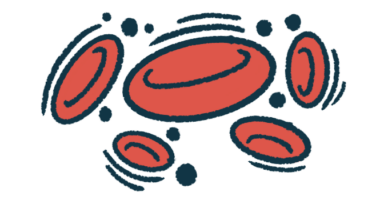Patients report favoring PiaSky in switch from Soliris in Phase 3 trial
84% of 38 adults in this group thought new PNH treatment easier to use

Most of the adults with paroxysmal nocturnal hemoglobinuria (PNH) who switched from Soliris (eculizumab) to PiaSky (crovalimab) in a clinical trial said they preferred PiaSky because it was easier to use, required fewer hospital visits, and took less time to administer.
That’s according to data from COMMODORE 2 (NCT04434092), a Phase 3 study that showed PiaSky to work as well as Soliris at controlling hemolysis, or red blood cell destruction, and freeing patients from a need for regular blood transfusions.
PiaSky was approved in China and Japan earlier this year for the treatment of PNH. It recently was approved in the U.S. to treat PNH in adults and children, ages 13 and older and weighing at least 40 kilograms (about 88 pounds). The therapy also has been recommended for approval in Europe by a European Medicines Agency committee. All these regulatory actions were backed by data from COMMODORE 2.
Trial findings were reported in the study, “Phase 3 randomized COMMODORE 2 trial: Crovalimab versus eculizumab in patients with paroxysmal nocturnal hemoglobinuria naive to complement inhibition,” published in the American Journal of Hematology.
PiaSky, a recently approved PNH treatment, is taken once each month
In PNH, a part of the immune system called the complement system becomes abnormally activated and destroys red blood cells, causing a wide array of symptoms. Anemia, or low numbers of red blood cells, often requires patients to receive frequent blood transfusions.
Like Soliris and Ultomiris (ravulizumab), PiaSky blocks complement activation by binding to a complement protein called C5. However, PiaSky is thought to offer a more convenient dosing schedule — once a month under-the-skin (subcutaneous) injections — than Soliris or Ultomiris, which can require more frequent dosing and generally are administered via into-the-vein (intravenous) infusions.
In the COMMODORE 2 study, 204 patients were randomly assigned to receive either PiaSky or Soliris for 24 weeks, or about six months. Patients then had the option to enter an extension period, where they either continued on their assigned therapy or switched to PiaSky.
The proportion of patients who had hemolysis under control, meaning blood levels of lactate dehydrogenase (LDH) less than 1.5 times the upper limit of normal from week five through week 25, did not differ between PiaSky and Soliris (79.3% vs. 79%). Of note, LDH is a marker of hemolysis.
About two-thirds of these patients also no longer required regular blood transfusion after treatment with PiaSky or Soliris (65.7% vs. 68.1%), showing that PiaSky is not worse than Soliris at controlling hemolysis and enabling patients to remain free of blood transfusions.
The two medications also worked equally well at preventing breakthrough hemolysis. This was defined as showing at least one new or worsening symptom or sign of hemolysis occurring inside blood vessels, along with having LDH levels equal to or higher than twice the upper limit of normal (10.4% vs. 14.5%).
Both treatments also resulted in higher Functional Assessment of Chronic Illness Therapy-Fatigue Scale (FACIT-Fatigue) scores, a patient-reported measure with higher scores indicating less fatigue. After six months, more than half of the patients in the two treatment groups reported less fatigue, seeing their FACIT-Fatigue scores increase by at least five points (58.6% vs. 54.5%).
Top reasons for favoring PiaSky were ease of use, shorter administration time
Of the 38 patients who switched from Soliris to PiaSky after the trial’s initial six months of treatment, a majority (84.2%) preferred PiaSky, while four (10.5%) preferred Soliris, and two (5.3%) had no preference.
“The top reasons for preference for [PiaSky] were ‘the way treatment was given was easier’, ‘fewer hospital visits associated with treatment’, and ‘time to administer treatment was shorter’,” the researchers wrote.
Side effects also were comparable, including the proportion of patients who experienced treatment-related serious side effects (3% vs. 1.4%), and side effects leading to dose modification (3.7% vs. 4.3%) or treatment discontinuation (0.7% vs. 1.4%).
“The COMMODORE 2 study demonstrated that [PiaSky] was non-inferior to eculizumab in both co-primary and key secondary efficacy endpoints, with a comparable and well-tolerated safety profile,” the researchers wrote.
PiaSky has an “overall favorable benefit-risk profile” and “offers a new treatment option for patients with PNH that is potentially less burdensome than existing therapies for this chronic lifelong disease,” they added.








